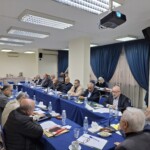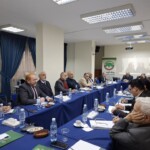Al-Zaytouna Centre for Studies and Consultations held a panel discussion, on 29/1/2025, titled “Trajectories of the Palestinian Situation in Gaza Strip and the West Bank After Operation al-Aqsa Flood.” The event, held at al-Zaytouna’s headquarters in Beirut, brought together specialists, researchers and experts in Palestinian political affairs and regional issues. Additionally, several participants from outside Lebanon joined the discussion via Zoom.
The panel discussion, moderated by Prof. Dr. Mohsen Mohammad Saleh, General-Manager of Al-Zaytouna Centre, took the form of an open dialogue.
Prof. Dr. Adnan al-Sayed Hussein, Lebanese Minister of State and Professor of Political Science at the Lebanese University, opened the session by describing the events in Gaza Strip (GS) as a testament to legendary steadfastness that exposed the West’s weakness. He emphasized that this military achievement must translate into political gains and urged wise Palestinians to take a decisive role in overcoming internal divisions. He argued that the Palestine issue suffers from the weakness and impotence of Arab governments and that the Muslim world has yet to fully assert its geopolitical and civilizational influence or articulate its future aspirations. He also stated that Israel has failed in its plans and that its greatest challenge now is the growing phenomenon of reverse migration from Palestine.
Ayman Shana‘ah, a political researcher and member of Hamas’s political leadership in Lebanon, stated that since the start of Operation al-Aqsa Flood, Hamas has been working on the GS future by attempting to put the Palestinian political house in order despite numerous obstacles. He emphasized Hamas’s commitment to this effort, rejecting any attempts by other parties to advance Israeli and US proposals. He asserted that the battle has laid a real foundation for the liberation project and highlighted various indications that the future belongs to the resistance, most notably Israel’s failure to achieve its objectives in the war.
Wisam Afifah, a Palestinian journalist and writer, stated that risks remain in GS, particularly in the pivotal phase following the war, where local and international interests intersect. Despite Israeli plans to reshape the territory, the Palestinian people have demonstrated unprecedented resilience, and the resistance has successfully thwarted efforts to impose a fully realized Israeli vision. Afifah outlined three possible scenarios: international negotiations leading to an interim administration under UN supervision, with Egypt or other Arab parties playing a role; renewed rounds of fighting, where Israel seeks to establish a new reality through military escalation; or, most likely, the emergence of a unified Palestinian national vision.
The fourth intervention was presented by Dr. ‘Abdul Halim Fadlallah, General Manager of The Consultative Center for Studies and Documentation in Beirut. He stated that the axis of resistance has proven its effectiveness and efficiency in this unconventional war, emphasizing that support is based on the integration of arenas rather than their unity. While unity involves GS, the West Bank (WB), the 1948 occupied territories and the Diaspora, the axis focuses on support and integration, not unity. He further explained that the resistance would not have evolved into an axis without being a reaction to three key issues: the US attack on the region in 2001, Religious Zionism’s efforts to undermine the Palestine issue, and the Arab and internal divisions arising from the Arab Spring.
Dr. Ahmed Atawneh, General-Manager of the Vision for Political Development Center, participated in the panel discussion where he emphasized the unprecedented settlement invasion in WB and the need for heightened vigilance. He noted that there is significant desire among Palestinians to resist and that the Palestinian Authority (PA) continues to rely on consensus with the US, seeking a future space for survival. Atawneh outlined four potential scenarios: the “Deal of the Century,” a new agreement that retains elements of the old deal with unknown amendments; the continuation of the status quo, with a fragile PA that keeps the political horizon open for Palestinians until the GS issue is resolved; the Israeli government taking radical steps toward annexation; or the implementation of the Decisive Plan, marked by intensified actions from Smotrich and a rise in the settler population to two million.
Haitham Abu Ghizlan, a political writer and leader in the Islamic Jihad movement in Palestine (PIJ), stated that all scenarios are still in play. He emphasized that Palestinian unity could be achieved by rebuilding the Palestine Liberation Organization (PLO) on new foundations and involving Hamas and the PIJ either through elections or consensus. Abu Ghizlan outlined four possible scenarios: first, the formation of a national reconciliation government, which he believes would be rejected by Israel and the PA leadership; second, the return of the PA to govern GS, which would also face Israeli rejection; third, Israeli security control while retaining settlement areas, allowing freedom of intervention, and establishing an administrative civilian government, which would likely face Palestinian opposition; and finally, the formation of a Community Support Committee, which, according to Abu Ghizlan, seems to be the most plausible solution given the current circumstances.
Ali Abu Yasin, head of the political bureau of al-Jamaah al-Islamiyyah (lit. The Islamic Group) in Lebanon, presented four scenarios: displacement, normalization and the “Deal of the Century,” relative stability in GS combined with instability in WB, and the possible collapse of negotiations leading to a return to war. He also offered three key conclusions: despite the challenges, Palestinian reconciliation remains an urgent priority; there is an immediate need for an “Alliance of the Free” globally; and a front must be established to confront the forthcoming normalization efforts.
Dr. Raed Hillis, a specialist in Palestinian economic affairs, highlighted the complexity of the GS reconstruction, which faces numerous challenges. Key obstacles include the ongoing Israeli blockade, which restricts the entry of essential materials for reconstruction and humanitarian aid; the destruction of infrastructure leading to a potential crisis of accumulating rubble; funding difficulties; food insecurity; displacement; and the deteriorating economic and social conditions due to the collapse of the economic structure, resulting in high poverty and unemployment rates. Hillis stressed the need for strategies that turn these challenges into opportunities for early recovery and reconstruction. He also emphasized the importance of adopting a unified national vision and a single Palestinian government to prepare a comprehensive plan to present to international bodies, aiming to mobilize funding and begin the reconstruction process without delay.
Finally, another group of experts and specialists made significant interventions and provided valuable comments.
Al-Zaytouna Centre for Studies and Consultations, 30/1/2025







Leave A Comment